As Above, So Below






As Above, So Below
Throughout most of the year, the nighttime skies of planet Veteris are illuminated by a vast, brilliant nebula. Tiny photosynthetic organisms multiply during the daylight hours, and after sunset the surface waters become a thick soup of predators ascending from the deep to feed on them. Any creature seen from below will be silhouetted against the glow of the sky above. To prevent becoming easy targets for predation, many blend in by producing their own light. In their swarming multitudes, these billions of incandescent swimmers create biological nebulae beneath the waves. Massive filter feeders like the ghostly white Niveus have no need for such camouflage. Their immense size and surprising speed are enough to keep them safe as they cruise these starry seas.
More Posts from Exobiotica and Others
I like your art. It is such a beautiful place and I can see Veteris being a wonderful place to explore in your art and world.
Thank you! I have a world full of ideas to bring to life, it just takes a long time.
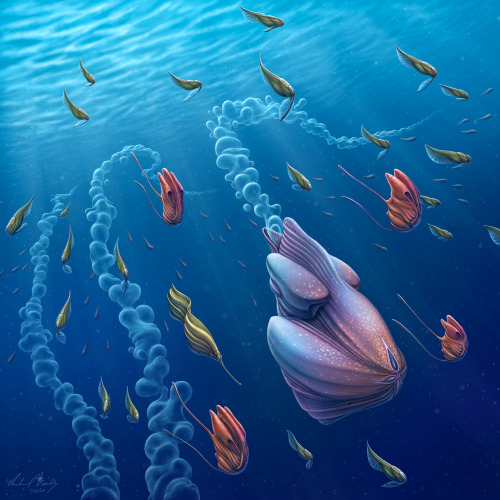
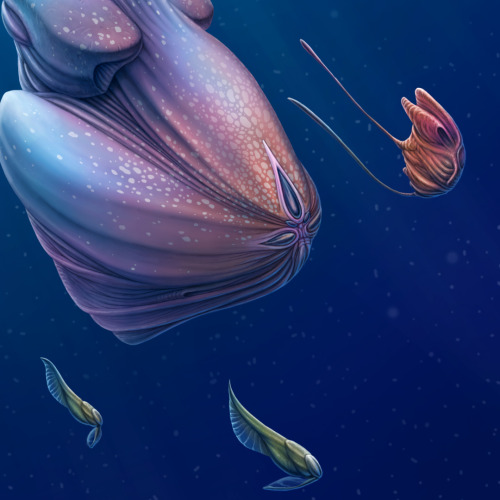
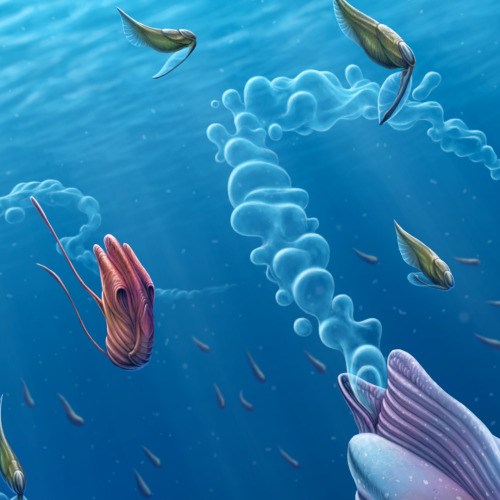
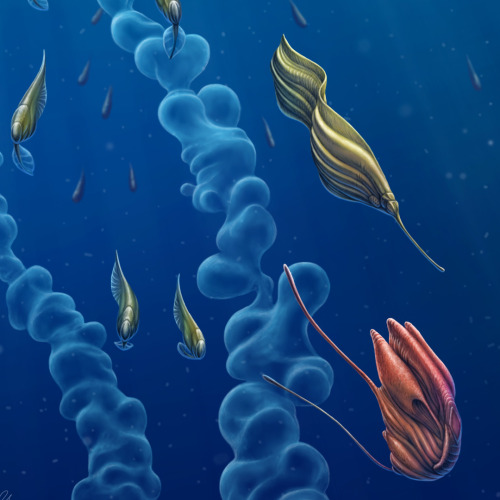
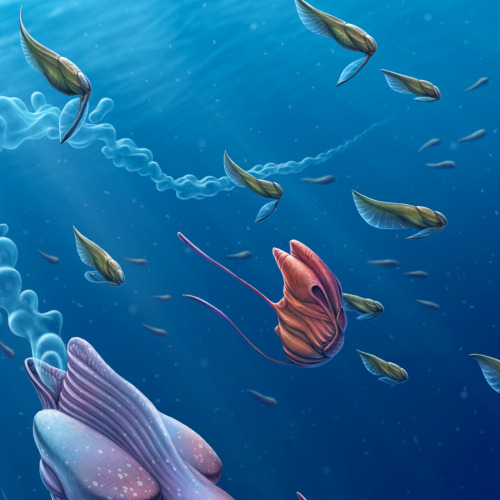
Back to the Depths
An entourage of opportunistic creatures accompanies the deep-sea behemoths during their brief ascent to the surface. Releasing their gelatinous strings of embryos here in the sunlight has a significant benefit - there's far more visibility. The swarm of followers are here in search of a quick meal in the form of the gelatin, which is full of valuable protiens and nutrients. After the feast however, the recipients of this apparent windfall become unwitting hosts for the behemoth's multitudinous offspring, which were embedded in the gel. Adapted to develop inside a wide variety of pelagic creatures, the young grow internally - and sometimes even on the surface of - their hosts until such time as they detach and sink back into the darkness. For most host species, this seems to be a mutually-beneficial symbiosis. At the beginning they receive a large and valuable meal, and usually incur very little detriment due to their temporary parasites. The young behemoths will hide in the dark depths for many years until attaining the size necessary to return to the light and repeat the ancient cycle again.
You are one of my biggest inspirations for creature design. Your aliens are beautiful and unique, and when I look at your art it feels like I’m actually there! Your art is beautiful
Thank you so much! I’m honored to be an inspiration for you.

Brand new website!
Check out Exobiotica.com for all your weird alien needs. Get prints, read new content, and go in-depth into the project. Enjoy!
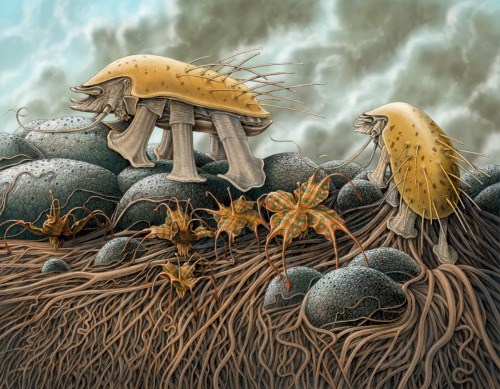
New Lands

Egg Chamber
In some environments, it's hard to tell the difference between genders and species. Organisms share genetic material more easily on this planet, and that leads to some complicated taxonomy. In this case, we see a group of aquatic creatures acting as nurses for a seemingly endless field of eggs. But the network of underwater chambers in which they reside is in fact another living creature. By some categorizations, it would be considered the female of the species - it produces and to some extent nourishes the field of eggs, some of which mature to be gigantic network-chambers themselves. Whether this is an extreme example of sexual dimorphism, or the result of some sort of horizontal gene transfer is a matter of conjecture at this point.

Quick personal promo!
When not drawing aliens, I'm a web/graphic designer. Here's my new portfolio site: michaelpbeaudry.com . Check it out if you are interested in other creative stuff I do.
I'm also on Instagram, DeviantArt, and Behance.
Ok, sorry- back to alien stuff now!

Luminous Oppugno
Submarinus luminare
Named for the Latin word for 'attack', the Luminous Oppugno is a crafty aquatic predator. Primarily nocturnal, it uses its bioluminescent-tipped rods to attract prey. Once within range, the main grasping appendage shoots out and arrests the unsuspecting victim with vigorous tenacity. Being fully aquatic (dwelling rather deeply at that) as well as nocturnal, the oppugno rarely comes into contact with sunlight, and thus has lost the capability of its ancestors to harness energy from photons. Thus, the creature must rely exclusively on its skill as a predator to meet its energy requirements. An adult oppugno usually tops out at around 5 feet long.
-
 delta-trox liked this · 3 weeks ago
delta-trox liked this · 3 weeks ago -
 ihaveapproximately4bones reblogged this · 1 month ago
ihaveapproximately4bones reblogged this · 1 month ago -
 shinythingsshinythings liked this · 2 months ago
shinythingsshinythings liked this · 2 months ago -
 annoyinglyuniversallytheori-blog liked this · 3 months ago
annoyinglyuniversallytheori-blog liked this · 3 months ago -
 malaidion liked this · 3 months ago
malaidion liked this · 3 months ago -
 salmonofwisdom liked this · 3 months ago
salmonofwisdom liked this · 3 months ago -
 sablesablesablesable liked this · 4 months ago
sablesablesablesable liked this · 4 months ago -
 randomideas666 liked this · 4 months ago
randomideas666 liked this · 4 months ago -
 fattcatt1123 liked this · 4 months ago
fattcatt1123 liked this · 4 months ago -
 aquasplatfest reblogged this · 5 months ago
aquasplatfest reblogged this · 5 months ago -
 pastel-junkyard liked this · 5 months ago
pastel-junkyard liked this · 5 months ago -
 potatosapien5 liked this · 5 months ago
potatosapien5 liked this · 5 months ago -
 alexivlao liked this · 5 months ago
alexivlao liked this · 5 months ago -
 modifiedyincision liked this · 5 months ago
modifiedyincision liked this · 5 months ago -
 john-frog liked this · 5 months ago
john-frog liked this · 5 months ago -
 dramatic-mice liked this · 5 months ago
dramatic-mice liked this · 5 months ago -
 cuntelbart liked this · 6 months ago
cuntelbart liked this · 6 months ago -
 planariaareneat reblogged this · 6 months ago
planariaareneat reblogged this · 6 months ago -
 planariaareneat liked this · 6 months ago
planariaareneat liked this · 6 months ago -
 fuckitwepost liked this · 6 months ago
fuckitwepost liked this · 6 months ago -
 sunsetsands liked this · 6 months ago
sunsetsands liked this · 6 months ago -
 drowsydrood liked this · 6 months ago
drowsydrood liked this · 6 months ago -
 celestriakle liked this · 6 months ago
celestriakle liked this · 6 months ago -
 hard-in-hightown liked this · 6 months ago
hard-in-hightown liked this · 6 months ago -
 brightmoontrigon reblogged this · 6 months ago
brightmoontrigon reblogged this · 6 months ago -
 philipkampp reblogged this · 6 months ago
philipkampp reblogged this · 6 months ago -
 bellabfield liked this · 6 months ago
bellabfield liked this · 6 months ago -
 sanktpolypenbourg reblogged this · 7 months ago
sanktpolypenbourg reblogged this · 7 months ago -
 mcpieandhaggis reblogged this · 7 months ago
mcpieandhaggis reblogged this · 7 months ago -
 darkwingphoenix liked this · 7 months ago
darkwingphoenix liked this · 7 months ago -
 kaznata liked this · 7 months ago
kaznata liked this · 7 months ago -
 foggyapricotnickeldream liked this · 7 months ago
foggyapricotnickeldream liked this · 7 months ago -
 bigbodds liked this · 7 months ago
bigbodds liked this · 7 months ago -
 futureshieldmaiden liked this · 7 months ago
futureshieldmaiden liked this · 7 months ago -
 delta-owo liked this · 7 months ago
delta-owo liked this · 7 months ago -
 crepuscular-girlthing liked this · 7 months ago
crepuscular-girlthing liked this · 7 months ago -
 tv1977 liked this · 7 months ago
tv1977 liked this · 7 months ago -
 mishikaiya reblogged this · 7 months ago
mishikaiya reblogged this · 7 months ago -
 lorrekeeper liked this · 7 months ago
lorrekeeper liked this · 7 months ago -
 ghostbird000 liked this · 8 months ago
ghostbird000 liked this · 8 months ago -
 merpdaberp liked this · 8 months ago
merpdaberp liked this · 8 months ago -
 iamnotyourbabe reblogged this · 8 months ago
iamnotyourbabe reblogged this · 8 months ago -
 santeri-surkea liked this · 8 months ago
santeri-surkea liked this · 8 months ago -
 critterbugboi liked this · 8 months ago
critterbugboi liked this · 8 months ago -
 starrycatupabove liked this · 8 months ago
starrycatupabove liked this · 8 months ago -
 loquora reblogged this · 8 months ago
loquora reblogged this · 8 months ago -
 jambojumbojumbo liked this · 8 months ago
jambojumbojumbo liked this · 8 months ago




